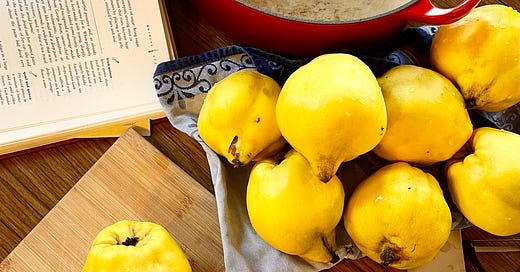Quince paste is one of those things that is often mistakenly characterised as complicated or difficult. It is neither, it simply takes time. The whole thing is cheaper than therapy and less self-involved. It just requires adherence to process and patience. The satisfaction of a process. Sense making through slow production. The result: a full stop to a sentence that makes sense.
The quince is a strange fruit. It looks like a prehistoric relative of the apple. It is wild, coarse and strong, lumpy with a strange waxy skin and stiff core that must be wooed by the patient to reveal fragrance and transformative colour. The apple seems industrial and plebeian in comparison. There is nothing wrong with that, it is a fine fruit of the everyman, but it holds little of the mystery of the quince. On the tree, the quince, like its stylish seasonal friend the persimmon, provides a last little moment of colour and beauty before the dull light and scent-less air of winter sets in. Its fruit hangs like an ornament on the trees’ branches, long after the leaves are gone, ripening slowly and, when cut open, offers an elegant perfume.
I may sound like a sycophant but I am not alone, indeed, I am in very good company. Patience Gray details the superior quinces she discovered while living on Naxos, describing them “with a delicate perfume, a luminous-green gold in colour, and not covered with the usual down”. In Greece, the quince is ‘kydoni’ and one makes ‘kydoni gliko’. She also speaks of the ‘cotognata’ from Lecce in Italy, where the quince is named ‘colony’. There the paste is handed out as treats for the children.
Some food processes are slow holes in time that bring rhythm and humming pleasure to hours spent in the process of making. I started making quince paste several years ago. I don’t plan exactly when I will make the paste. I wait for a day when I need the activity to slowly weed out riddles in my head and buzzy anxieties in my body. A day, or evening, of tending to the stove to help tie up the loose ends in my mind. The resulting three kilos of paste provide a satisfying sense of purpose and reward.
Sourcing the quinces themselves can be interesting. Another part of the process. Last year I woke one Sunday with a rather bleak hangover that was so mammoth it felt as though a reckoning was upon me. It is never good when you make it to the other side of hedonism. The real trick is to learn to enter the forest but never go so deep the only way out is through. I had gone too deep, was meeting with my maker and was in a sea of self loathing. I repented by scrambling down into wild overgrown orchards off the backroads of the Adelaide Hills, where I was living. This strange little part of the world is made up of hills dotted with either forest, orchards or vineyards. A good friend took me wandering one day and showed me down a dirt track that seemed like a forgotten eden. There, among the gums and stringy barks were neglected walnut, quince, apple, plum and lemon trees that were all happily wilding themselves into the landscape, the bramble of the ferocious blackberries helping them fend off any unwanted attention.
This year my friends mum had some growing on her farm. A few of us once went to said farm and, upon taking advantage of a sunny spot had a nap on the Saturday afternoon. She is a woman who runs a dairy farm and works as a lawyer. She wakes at 4.30 and sleeps at 10pm every day like clockwork. Upon seeing us she said, confused and taken aback, “what are they doing?!” So unfamiliar with the notion of rest for rests sake was she, that our idleness made no sense. She is a good one for shaking out your bourgeois pride in simple processes. Quince paste? sure. Pickles, yes, have been bottling them for the past thirty years. She seems to say ‘you want a fucking medal?’
While I have my way of making the paste that has served me well, I check my hubris and consult with the matriarchs. Both Stephanie Alexander and Elizabeth David kindly warn to place a tea towel around your wrist as in case any of the boiling, bubbling mixture “erupts and spits” up onto you as you stir it. Elizabeth and Patience both roast the quinces whole in the oven before putting it on the stove with the sugar. This is surely the right way as both were taught by those who have done it for hundreds of years. I’ll try it next year. This year I went with what I know and Stephanie does it too: peeled and quartered, most cores removed, a few stay for pectin. The only challenge is patience - the longer you stir the darker the colour gets.
I am now slowly drying the paste in the oven. I leave it in there and every time I’m home I turn it on on low, waiting for it to lose some of its watery-sticky sheen. Again, process and patience. Soon I will sit down with it and cut it into small squares, wrap them in baking paper and begin handing them out to people, keeping enough for myself to have with cheese, use with duck or reduce it back down for a syrup for a cake throughout the year.






Stunning Caitlin